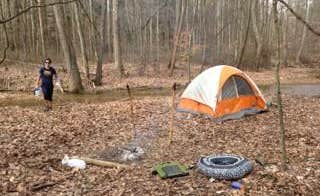Dispersed camping near Wellington, Kentucky provides rustic outdoor experiences centered on the Knobstone Trail system. The region features limestone formations called knobs that create challenging elevation changes throughout the hiking routes. Remote camping options exist along various sections of trail with seasonal water availability that depends on recent rainfall patterns.
What to do
Hike challenging terrain: Knobstone Trail offers significant physical challenges for backpackers seeking primitive camping spots. "Most people, even Hoosiers don't realize the Knobstone Trail exists. It's often referred to The Little AT by those who know about it. It's no walk in the park," shares Dave E. about the trail's difficulty level.
Fossil hunting: Look for natural history specimens along creek beds while hiking to your camping spot. Several water crossings contain paleontological features of interest to amateur collectors and geologists.
Enjoy quiet solitude: Jackson Trailhead provides less-visited camping opportunities away from more populated areas. "There's parking after a decrepit gravel road and suitable for camping. There are campsites along the trail just have to find them," notes loganx11 about the somewhat hidden nature of these rustic sites.
What campers like
Bailout options: The trail system design allows for emergency exits if weather turns dangerous or supplies run low. "There are road crossings every 5 to 10 miles, so if you run out of something or need to bail you can," explains Maris H. about the practical layout of the trail network.
Spacious sites: When facilities are available, they offer comfortable separation between camping parties. "The sites are spacious, and there are a lot of nature things to do," reports Susan C. about the less primitive sections of the area.
Detailed mapping: Online resources provide necessary navigation tools for planning remote camping trips in the Wellington region. Trail maps showing water sources, elevation changes, and camping zones can be found through official park websites.
What you should know
Access challenges: Certain trailheads have unclear entry points that may cause confusion for first-time visitors. "Maybe Google Maps took me to the wrong place. I drove back and forth on the road several times looking for this place. The only thing I found was what I believe was the entrance with a cable across it," warns Desert B. about navigation difficulties.
Tick prevention: Warm weather months bring significant insect activity. Long pants, proper repellents, and nightly tick checks are essential during spring and summer camping trips in this area.
Water filtration required: All water sources in this primitive camping region require proper treatment. Campers should carry filtration systems and not rely on finding clean drinking water sources during dry periods.
Tips for camping with families
Family-friendly sections: Some portions of the camping area offer more accessible terrain for younger hikers. "The entire park is just beautiful. It's very family friendly and quiet," notes Susan C. about certain regions that accommodate children better than the more challenging sections.
Educational opportunities: Incorporate nature study into your camping trip by identifying fossils, local plant species, and geological formations with children.
Shorter loop options: Plan family camping trips on shorter trail segments rather than attempting through-hikes with younger campers. Several 2-3 mile loops provide suitable camping spots without requiring long-distance hiking.
Tips from RVers
No RV accommodations: The dispersed camping areas near Wellington strictly serve tent campers and backpackers. No vehicle camping sites exist along the main trails.
Parking limitations: Trailhead parking areas have limited space and cannot accommodate large vehicles or trailers. Standard passenger vehicles provide the only reliable access to hiking routes leading to camping areas.
Leave no trace: Primitive camping regulations require strict adherence to environmental protection practices. "The KT asks that you respect leave no trace philosophy, and I felt most hikers did," shares Maris H. about the conservation ethic expected from all visitors.


